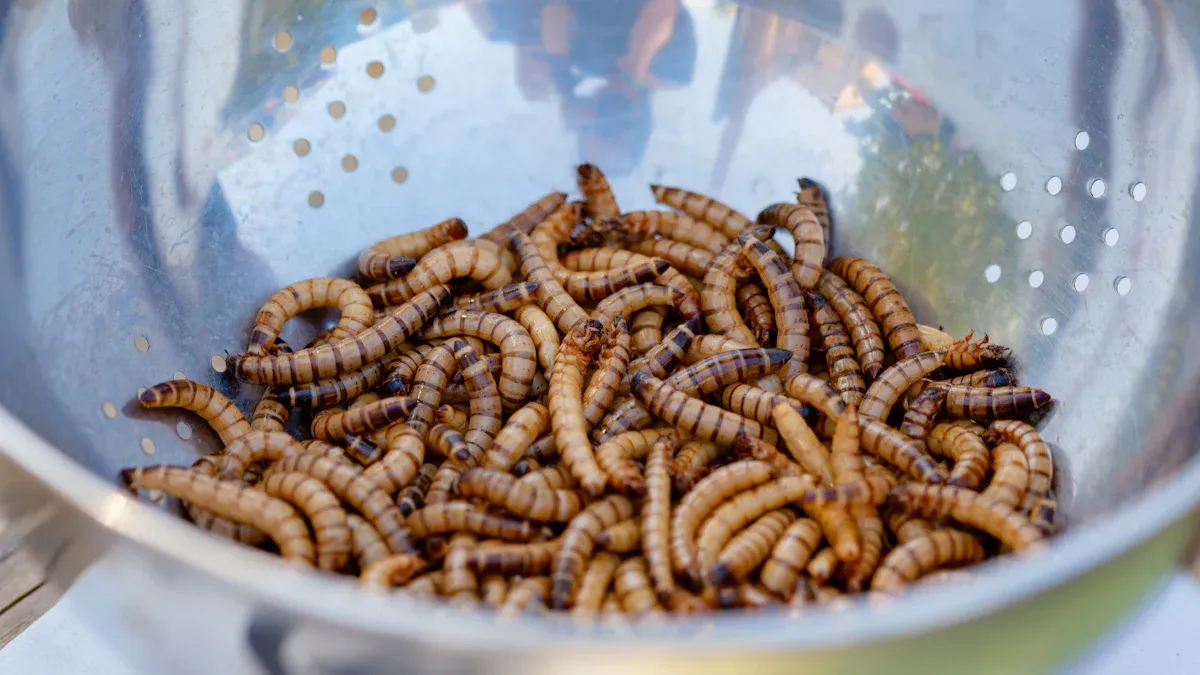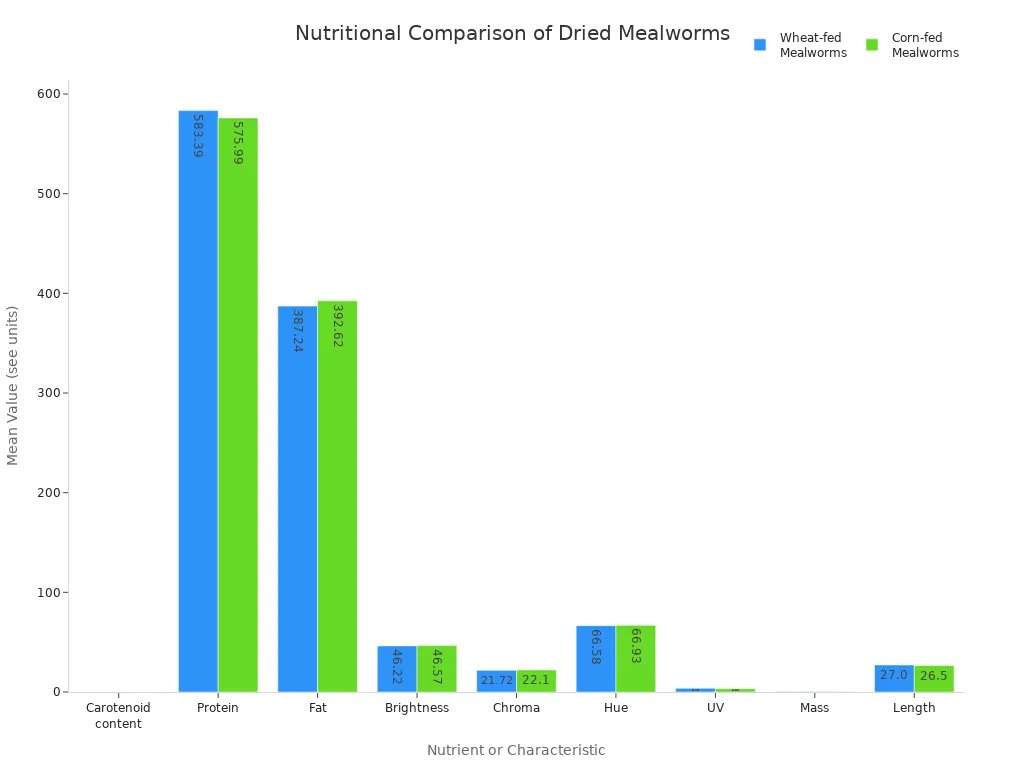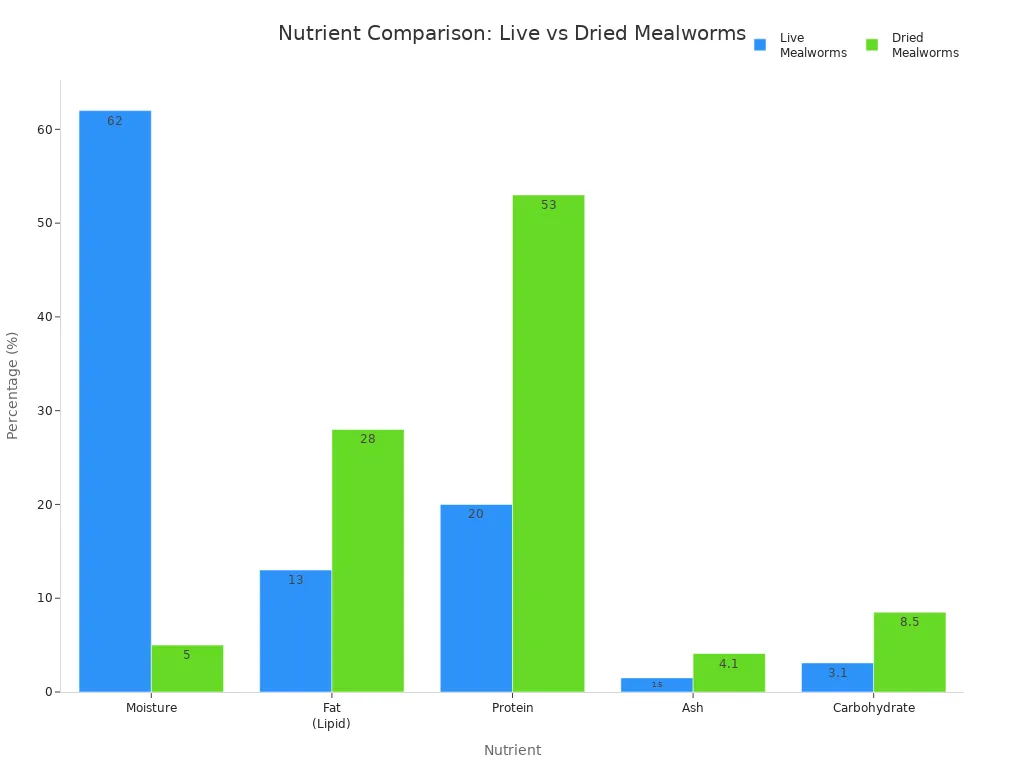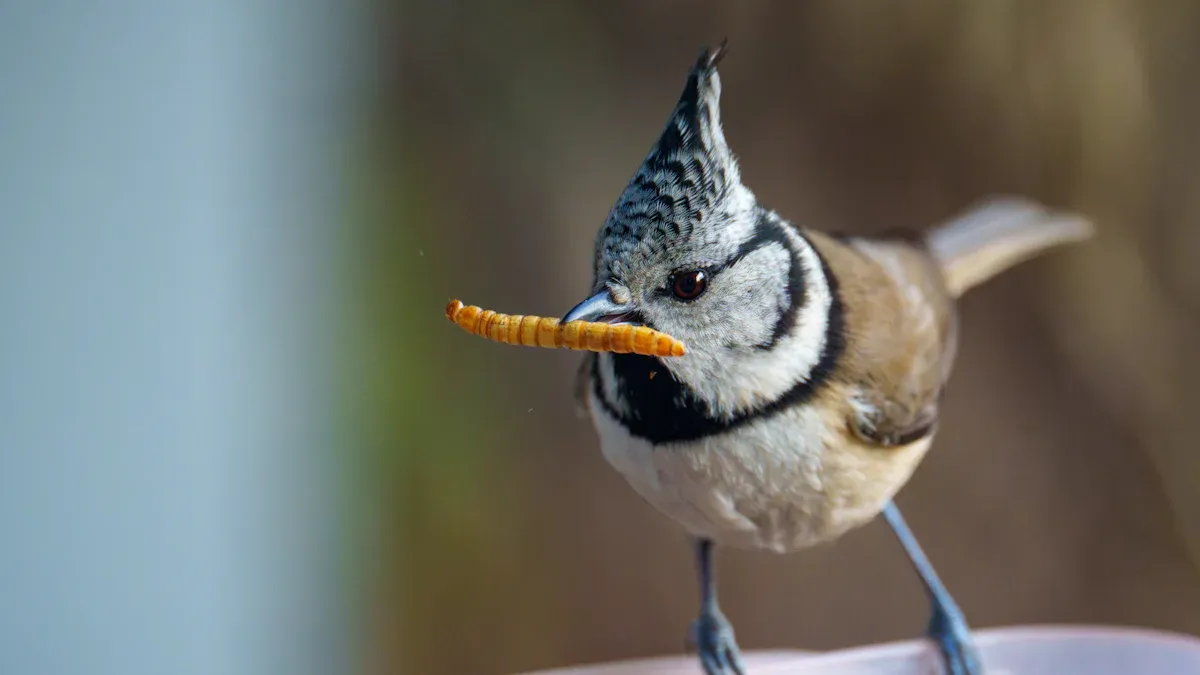
Dried Mealworms for Birds deliver outstanding nutrition, boasting about 60% protein and 28% fat. Birds benefit from essential minerals and vitamins, making these treats a top choice for year-round feeding. Their popularity continues to soar worldwide, with millions of tons produced annually.

Key Takeaways
- Dried mealworms provide wild birds with high protein, essential fats, vitamins, and minerals that support their growth, energy, and overall health.
- Offering dried mealworms, especially when soaked, helps birds stay strong during cold weather, breeding, and migration seasons by giving them extra nutrition and hydration.
- Using proper feeders, feeding in moderation, and mixing mealworms with other foods attract more bird species and keep birds healthy and safe year-round.
Dried Mealworms for Birds: Nutritional Benefits
High Protein and Energy Content
Dried Mealworms for Birds deliver a powerful protein punch. Scientific studies show that dried mealworms contain about 53% protein on average, sometimes reaching as high as 63%. This level matches or even surpasses the protein found in traditional bird feeds like soybean meal or fish meal. Birds need protein for muscle growth, feather development, and tissue repair. The high-quality protein in mealworms also offers excellent amino acid digestibility, making it easy for birds to absorb and use these nutrients.
Wild birds require energy-rich foods, especially during migration, cold weather, or breeding seasons. Dried mealworms provide a balanced mix of protein, fat, and fiber, which fuels birds through demanding periods. Seeds and suet also offer high energy, but mealworms stand out as a natural, insect-based option that many birds instinctively recognize as food. This makes them a valuable addition to any bird feeding routine.
Tip: Offering dried mealworms during autumn and winter helps birds survive frosty nights by giving them the extra calories they need.
Essential Fats, Vitamins, and Minerals
Mealworms are not just about protein. They also supply essential fats that keep birds healthy and active. These fats help birds maintain vibrant feathers and healthy skin. Birds use the energy from these fats to stay warm and alert, especially when temperatures drop.
The vitamin and mineral content in dried mealworms supports many aspects of avian health. The table below highlights some of the most important nutrients and their roles:
| Nutrient Type | Most Abundant Nutrients | Roles in Avian Nutrition |
|---|---|---|
| Vitamins | B2, B5, B7, B12 | Support energy metabolism, red blood cell production, nervous system health |
| Minerals | Potassium (K), Calcium (Ca), Iron (Fe), Magnesium (Mg) | Strengthen bones, improve muscle function, boost immunity, aid eggshell formation and bone development |
Birds benefit from these nutrients every day. For example, calcium and magnesium help build strong bones and eggshells, while B vitamins keep birds energetic and alert.
How Dried Mealworms Support Bird Health
Supplementing wild birds’ diets with dried mealworms leads to visible improvements in their health. Birds with access to feeders containing mealworms often show stronger immune systems and better antioxidant levels. These antioxidants help birds resist stress and recover from illness more quickly. Studies also reveal that birds eating supplemental mealworms grow longer, healthier feathers, which is a sign of good nutrition.
Birds that receive regular mealworm feedings often display improved body condition. They store more fat, which helps them survive harsh weather and periods of food scarcity. In some species, mealworm supplementation has increased survival rates for both adults and fledglings. Research also shows that food availability can boost breeding productivity, leading to higher hatching and fledging success.
Dried Mealworms for Birds offer a natural, nutrient-rich supplement that supports wild birds’ immune function, feather quality, and overall vitality. By adding these treats to backyard feeders, bird lovers can help their feathered visitors thrive throughout the year.
Dried Mealworms for Birds vs. Live Mealworms
Nutritional Comparison
Bird lovers often wonder if dried or live mealworms offer better nutrition for wild birds. Both types provide valuable protein and fat, but their nutritional profiles differ because of moisture content. The table below shows the main differences:
| Nutrient | Live Mealworms (%) | Dried Mealworms (%) |
|---|---|---|
| Moisture | 62 | 5 |
| Protein | 20 | 53 |
| Fat | 13 | 28 |
| Ash | 1.5 | 4.1 |
| Carbohydrate | 3.1 | 8.5 |

Dried mealworms contain much less moisture, so their protein and fat percentages appear higher. When rehydrated, their nutritional value becomes closer to live mealworms. Both forms supply essential nutrients, but live mealworms offer more natural moisture, which helps birds stay hydrated. Dried Mealworms for Birds, however, deliver concentrated protein and fat, making them a powerful energy source, especially during cold months.
Palatability and Bird Preferences
Wild birds often show a clear preference for live mealworms. The movement of live insects triggers their hunting instincts, making them more attractive and easier to spot. For example, bluebirds and robins usually choose live mealworms first. Some birds may hesitate to eat dried mealworms at first, but they can learn from others in the flock. Once one bird tries dried mealworms, others often follow.
Tip: Soak dried mealworms in water for a few hours to make them juicier and more appealing. This simple step can help birds accept them faster.
Some species, like bluebirds, may reject dried mealworms unless they are mixed with other foods or rehydrated. However, many backyard birds, including robins, starlings, and sparrows, will eat dried mealworms, especially when food is scarce. Over time, birds can adapt and enjoy both types, especially if dried mealworms are offered regularly.
Practicality and Storage
When it comes to convenience, dried mealworms stand out. They require no refrigeration, last much longer, and are easy to store in a sealed bag or airtight container. This makes them ideal for busy bird enthusiasts or those who want to keep a steady supply on hand. Dried mealworms can be stored for months without spoiling, and they blend easily with seeds or suet.
Live mealworms need more care. They must be kept cool, fed fresh vegetables, and stored in ventilated containers to stay healthy. This process takes time and effort. Live mealworms also cost more and have a shorter shelf life, usually lasting only a few weeks unless refrigerated. Handling live insects can be messy and may not appeal to everyone.
-
Dried mealworms offer:
- Long shelf life
- Easy storage
- No need for refrigeration
- Simple feeding options
-
Live mealworms require:
- Regular feeding and care
- Cool storage to prevent pupation
- More time and higher cost
For most backyard bird feeders, dried mealworms provide a practical, affordable, and nutritious choice. They attract a wide range of birds and fit easily into any feeding routine.
Bird Species Attracted to Dried Mealworms for Birds

Common Backyard Birds
Many backyard birdwatchers hope to attract a variety of species with Dried Mealworms for Birds. Chickadees and catbirds show the most frequent interest in dried mealworms, although their enthusiasm can vary. Some chickadees eat dried mealworms eagerly, while others approach them with caution. Catbirds may pick at dried mealworms, but often do so without much excitement. Most other common backyard birds, such as cardinals, prefer live mealworms and may ignore dried ones. However, when food is scarce, more birds may try dried mealworms, especially if they see other birds eating them.
Tip: Place dried mealworms in a visible feeder to help birds discover this nutritious treat.
Benefits for Nesting and Young Birds
Dried mealworms provide essential protein and fat that support nesting birds and their chicks. Parent birds need extra energy during the breeding season, and young birds require protein for strong feathers and healthy muscles. Studies show that feeding mealworms to species like reed warblers, house sparrows, and great tits improves chick survival and boosts breeding success. In Sweden, female northern wheatears fed with mealworms weighed more and delivered mealworms to their chicks soon after hatching. Rehydrating dried mealworms makes them easier for young birds to eat, helping them grow and thrive.
| Bird Species | Benefit from Mealworms |
|---|---|
| Reed Warblers | Higher breeding success |
| House Sparrows | Improved chick survival |
| Great Tits | Better fledging rates |
| Northern Wheatears | Healthier, heavier females |
Seasonal Feeding Advantages
Feeding dried mealworms during breeding and migration seasons gives wild birds a powerful nutritional boost. Protein supports muscle growth, feather repair, and chick development. Healthy fats provide lasting energy for long flights and help birds recover quickly. Vitamins and minerals strengthen bones and boost the immune system. Soaked mealworms add hydration, which is especially helpful in hot weather or for young birds. Offering mealworms during these critical times helps birds stay strong and encourages them to return to your feeders year after year.
How to Feed Dried Mealworms for Birds Effectively
Choosing Feeders and Feeding Methods
Bird lovers can attract more birds by choosing the right feeder. Platform feeders or rimmed dishes work best because they keep mealworms contained. Hanging platform feeders bring in bluebirds, woodpeckers, wrens, and titmice. Placing feeders near bushes or trees gives birds a safe place to land and hide. The Perky-Pet® Dried Mealworm Bird Feeder with Flexports® uses flexible rubber ports to keep mealworms fresh and dry. This feeder design helps birds feed naturally and keeps the food safe from rain.
Tip: Place feeders away from windows to protect birds from collisions.
Mixing with Other Foods and Portion Sizes
Mixing mealworms with other foods creates a balanced diet for wild birds. Sunflower hearts, suet cakes, fresh fruit, black sunflower seeds, and peanuts add healthy fats, energy, and vitamins. This mix attracts more bird species and supports their health.
| Bird Type | Portion Size | Feeding Frequency | Notes |
|---|---|---|---|
| Small garden birds | Small handful | Once daily | Prevents overfeeding and keeps food fresh. |
| Larger birds | Slightly more than a handful | Once daily, more in nesting | Extra protein needed during breeding. |
| General wild birds | Small handful | Once daily, year-round | Mix with seeds or suet for variety. |
| Seasonal adjustment | Increase in spring/summer | More frequent in breeding | Supports nesting and chick-rearing. |
Note: Offer mealworms in small amounts to avoid waste and spoilage.
Hydration Tips and Rehydrating Mealworms
Soaking dried mealworms in warm water for 10-30 minutes makes them juicy and easier for birds to eat. This helps young birds and provides extra hydration during dry weather. Always serve small amounts and remove any uneaten soaked mealworms at the end of the day. Clean feeders often to keep birds healthy.
- Soak mealworms before feeding.
- Discard leftovers daily.
- Clean feeders regularly.
Storage and Bag Size Options
Proper storage keeps mealworms fresh and safe. Store them in an airtight container in a cool, dry place. This prevents spoilage and keeps out pests. Oven drying and blanching during processing help maintain quality for at least three months. Choose the right bag size for your needs. Smaller 100g and 500g bags are perfect for beginners or as a snack. The 1kg bag offers great value for regular feeding. For those with many hungry birds, 5kg and 12.55kg bags provide the best supply.
Keep mealworms sealed and dry to preserve their nutrition and taste.
Addressing Concerns About Dried Mealworms for Birds
Safety and Moderation
Feeding wild birds requires care and responsibility. Bird enthusiasts should always offer dried mealworms in moderation. Too many mealworms can lead to overconsumption, which may cause health problems for birds. Experts recommend the following safety guidelines:
- Serve dried mealworms as an occasional treat, not as the main food source.
- Offer small quantities at each feeding.
- Soak mealworms in warm water for about 30 minutes before serving to improve digestibility.
- Remove any uneaten soaked mealworms after one or two days to prevent spoilage and mold.
- Use feeders that keep mealworms dry and protected from rain.
Proper feeder maintenance and portion control help keep wild birds healthy and safe.
Hydration Needs and Young Birds
Young birds and nestlings have special dietary needs. They require foods that provide both moisture and a complete range of nutrients. Dried mealworms, when fed dry, lack the natural moisture found in live insects. This can lead to dehydration or digestive issues, especially for chicks. Soaking dried mealworms before feeding helps add moisture, making them easier to eat and digest. However, experts advise against feeding dried mealworms to baby birds as their main diet. Young birds thrive best on a varied and balanced diet that meets all their nutritional needs.
Impact on Bird Behavior and Breeding
Supplementary feeding with mealworms can support adult birds during breeding and migration. Studies show that birds like pied flycatchers and Florida scrub jays benefit from extra protein, showing better survival and body condition. Most research focuses on live mealworms, which provide more moisture and nutrients. Dried mealworms, when used responsibly, can still offer valuable energy. Responsible feeding encourages healthy bird populations and supports breeding success. Bird lovers should always use moderation and variety to promote natural foraging and balanced nutrition.
Dried mealworms offer wild birds a safe, nutritious, and easy supplement. They help birds stay healthy and attract many species to the yard. Bird lovers should use the right feeders and portion sizes. Responsible feeding ensures birds thrive all year. Give your backyard birds the best care today!
FAQ
Are dried mealworms safe for all wild birds?
Dried mealworms provide safe, nutritious food for most wild birds. Bird lovers should always offer them in moderation to support healthy diets and avoid overfeeding.
Can dried mealworms be mixed with other bird foods?
Yes! Mixing dried mealworms with seeds or suet attracts more bird species. This combination gives birds a balanced diet and keeps them coming back for more.
Do you offer smaller bags of dried mealworms?
Absolutely! Customers can choose 100g or 500g bags for a convenient snack size. These options make it easy to start feeding birds and enjoy great value.


